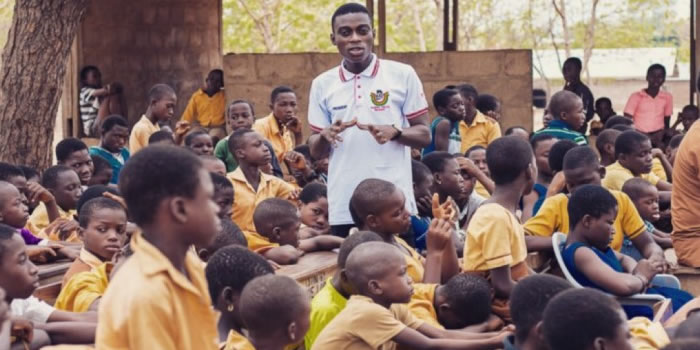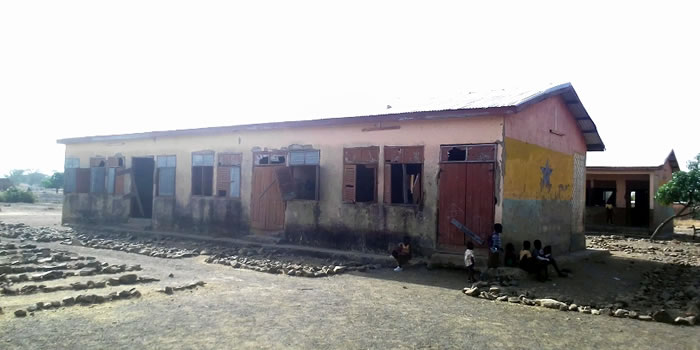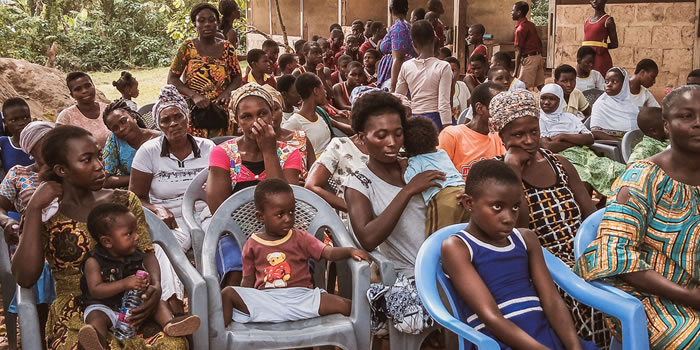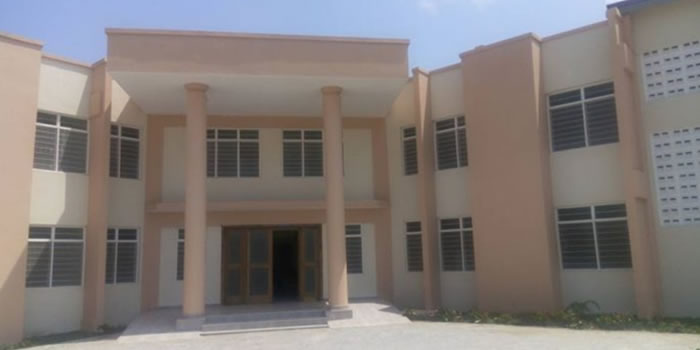

EDUCATION
Talensi-Nabdam District Lacks Educational Infrastructure
Education in the Talensi-Nabdam District in the Upper East Region is threatened as some communities in the area have no schools, and where they exist they have extremely poor infrastructure and pupils have to ride or walk many kilometres to access education daily.

Date Created : 1/6/2010 12:00:00 AM : Story Author : GNA/ Eric Amo
Some of the communities in the area the GNA visited have never benefited from any government infrastructure, interventions or support. They include Bapella; Degaare; Zanware; Yale and Tolla.
At Bapella, for instance which has a population of about 500, there was only a mud structure with a narrow opening the people describe as a door and a hole on one of the walls which served as a window. The community put up that structure to serve as a classroom for classes one and two.
In this classroom, there was no chalk board and so a part of the wall of the structure was used as a chalk board. The children did not have tables or chairs. What separated the two classes housed in the same classroom was a beam used to support the structure. The children sat in this classroom with their legs stretched. There was no teacher at the time of the visit.
The upper class, which is class three and class four, was under a shea nut tree. The children were sharing this "classroom" as usual. Here, they had something to call chair and table. The chairs were two logs, one for each of the classes. The class three was directly behind class four. The tables for these pupils were five gallon rubber containers, popularly called Kufuor gallons.
This was the classroom with a teacher, who had volunteered to teach the children in his community to become scholars in the future. He gave his name as Peter Boare.
According to Mr Boare, he had just taken over the teaching job from another person who left the job to further his education.
He said parents in the community are enthusiastic about giving their children education even though they themselves were illiterates. "They sew school uniform for their children, buy exercise books and once in a while visit the school to get information about the performance of their children," he said.
Mr Boare told the GNA that the community members contributed one Ghana Cedis per child for him as allowance at the end of every month.
"The children here are 28 on the roaster and so at the end of every month I am expected to get 28 Ghana cedis. At times some do not pay cash; they bring food stuffs and meat as their contribution."
Mr Boare said the community members built the one mud structure classroom block, for their children to receive some education after several calls on the Assembly to provide a classroom block had fallen on deaf ears.
The GNA observed that the Bapella community has no health facility. The only one close to that community is a Presbyterian Health Centre at Tolla, which is about 11 kilometres from Bapella. In times of emergency the community members fall on any of the three people with motorbikes including a Fulani settler.
The classrooms at the Tolla community are not too different from the Bapella one even though it has classes one to six. They were mud structures with small holes that served as windows.
Pupils, who complete primary school here, have to travel on bicycles for about three hours for lessons at a junior high school at Datoko. Parents who cannot afford bicycles move their children to stay with relatives and friends at Datoko to get JHS education. Those who cannot have these benefits end their educational career after class six.
This school has a Head Teacher and three volunteer teachers from the National Youth Employment Programme. An old mud structure which hitherto served as a clinic for the Presbyterian Clinic is now used to house the teachers and serve as an office for the Head Teacher.
The Head Teacher said individual members of the local Presbyterian Church sometimes donated books to the school adding that following the absence of a JHS in the community some of the children abandoned school and migrated to some of the mining areas to engage in "galamsey" activities.
He said the school has a population of about 120 and that there were many more children in the community, who were not attending school.
The Head Teacher, who has formally retired from the Ghana Education Service (GES), appealed to the GES to post teachers to the area to augment the existing number. He further appealed to the Managers of the School Feeding Programme to extend their services to the school.
The District Director of Education, Mr Francis Ayaaba said proposals had been sent for the construction of a primary and a junior high school at Tolla.
With respect to Bapella, Mr Ayaaba said the community recently wrote to his outfit requesting the establishment of a school in that community.
He said already a committee has been assigned to assess the feasibility of establishing the school adding that the outcome would basically depend on the report of the committee.
The District Chief Executive, Ms Vivian Anafo corroborated what Mr Ayaba said adding that the Assembly had prioritized education, however, it was handicapped in providing the needs of the various communities at the same time.
She said the Assembly has committed itself to providing infrastructure, especially educational related ones. She said even though some schools in the District were still holding classes under trees, the Assembly was collaborating with the District Directorate of the Ghana Education Service to provide classrooms.
Ms Anafo said she had known about the concerns raised by the communities when she worked with Equal; a nongovernmental organization (NGO) operating in the area.
She indicated that the Assembly had already responded to some of the requests made by the GES in terms of the provision of educational infrastructure and said five communities including Datoko; Sakoti; Gane-Asonge; Gari-Gbane and Sheiga have been provided with early childhood development centres, while Obuoasi, a mining community has been provided with a block of three classrooms. A JHS has also been constructed for the Nangodi community.
She said the Assembly had constructed a teacher's quarters at Tongo Beo; a block of six classrooms at Namoranteng and had re-roofed some schools whose roofs were ripped off during rainstorms some years ago.
Ms Anafo expressed gratitude to managers of the European Union Project; Northern Flood Project Secretariat and the Assemblies of God Relief and Development Services for their interventions in the provision of infrastructure in the areas of education and health in the District.
Another key observation the GNA made was the fact that most of the community members were not subscribers of the National Health Insurance Scheme. According to a community nursing officer at the Presbyterian Health Post at Tolla, Mr Joseph Achana, he had personally made efforts to collect the names of interested people from the community to be registered "but the people cannot simply afford," he said.
Many of the roads in the area were in bad state. For example, the roads leading to Biung and Nungu were very bad.






 facebook
facebook
 twitter
twitter
 Youtube
Youtube
 +233 593 831 280
+233 593 831 280 0800 430 430
0800 430 430 GPS: GE-231-4383
GPS: GE-231-4383 info@ghanadistricts.com
info@ghanadistricts.com Box GP1044, Accra, Ghana
Box GP1044, Accra, Ghana